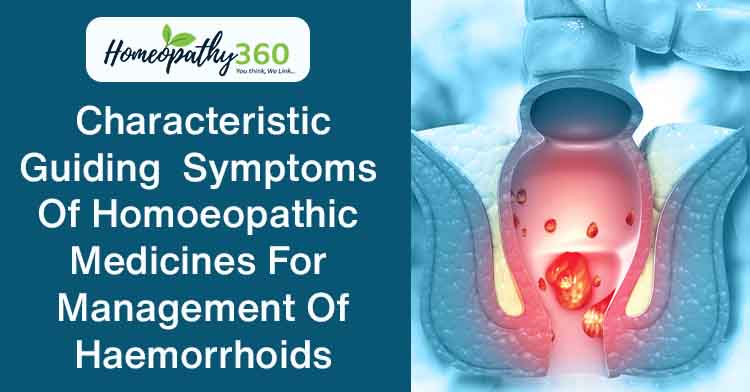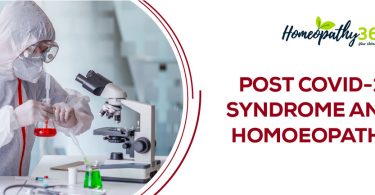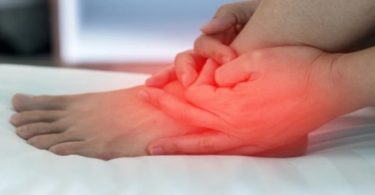
Abstract:
Haemorrhoids are a very common disease condition nowadays which is characterized by bleeding during stool and protrusion of lumps at the anal orifice. It is a very discomforting ailment and can be painful as well. In homoeopathy, we have plenty of medicines of medicines for its management. In this article, some common and rare medicines are selected from W.BoerickeMareriamedica& repertory and its key indications are mentioned in precise form so that it can be used a quick reference to differentiate among the remedies and choose the appropriate similimum.
Keywords: haemorrhoids, piles, homoeopathic medicines, homoeopathy
Introduction:
Haemorrhoids is derived from Greek word haima (bleed) and rhoos(flowing) which means bleeding. It is commonly called as piles which is derived from latin word pila which means ball.[1] It is caused due to congestion of internal or external or both venous plexuses around the anal canal.[2] It is associated with pregnancy, constipation and straining, low fibre diet, diarrhea, obesity and portal hypertension. It is of two types – internal and external haemorrhoids. Internal haemorrhoids lies above the dentate line and is covered by mucous membrane. It is further divided into primary haemorrhoids which lies at the 3,7 and 11o’clock position and secondary haemorrhoids which lies between the primary sites. External haemorrhoids lies below the dentate line and is covered by skin. [3] Clinical features include bright red painless bleeding seen on the toilet paper or as a fresh splash in the pain. Patient complaints of lumps that appear at the anal orifice.Haemorrhoids are classified under four grades. 1st degree piles is associated only with bleeding, no prolapse is seen. In 2nd degree there is prolapse during stool but it reduces spontaneously while in 3rd grade it needs to be reduced manually. In 4 th grade, it is permanently prolapsed. Patient may suffer with anal irritation due to mucous discharge.[1]
Homoeopathic management:[4]
- Abrotanum:
The patient has frequent urge for stool with sensation as if bowels were sinking down. Bloody stools and oozing from umbilicus.Complaints are worse as rheumatic pains abate.
- Aconitum napellus:
Bleeding haemorrhoids with pain and pruritus at anal region at night. The patient is anxious and restless and children cries and complain much and are sleepless and full of anxiety.
- Aesculushippocastanum:
There is marked engorged haemorrhoidal veins with little bleeding and much pain after stool with prolapse. There is characteristic backache and makes the patient unfit for business. There is absence of actual constipation. Rectum feels full of small sticks. Mucous membrane appears swollen and obstructs the passage. The patient experiences burning in anus with chills up and down the back. Complaints worse during climacteric.
- Aloes socotrina:
It has marked action on portal congestion. It suits best to those who has sedentary lifestyle or habits. Haemorrhoids protrude like grapes which are very sore and tender. Burning in anus and rectum which is relieved by cold water application. There is feeling of weakness and loss of power of anal sphincter. Stools are jelly like with discharge of much mucus and pain in rectum after stool.
- Ammonium muriaticum:
Haemorrhoidsoccur after suppressed leucorrhea. There is much itching and soreness in anal region and stinging in the perineum. There is burning during and after stool.
- Apismellifica:
Stools are bloody and painless but there is singing sensation after confinement. Rawness of anus. Constipation with sensation as if something would break on straining.
- Arsenic album:
Haemorrhoids burn like fire yet relieved by heat. Stool bloody and offensive. Skin around the anus is excoriated.
- Barytacarbonicum:
Haemorrhoids protrude when the patient urinates. Stools are hard and knotty.
- Belladona:
Piles with backache and shuddering during stool and stinging pain in rectum.
Calcareafluorica
Patient suffers with internal piles frequently with pain in back, down on the sacrum and constipation. Complaints worse during pregnancy.
Capsicum:
Bleeding piles with soreness of anus. There is stinging pain during stool and backache after stool with thirst and shivering. There is discharge of bloody mucus with burning and tenesmus.
Carbovegetabilis:
White haemorrhoids with excoraiation of anus.Bluish, burning piles with pain after stool.Frequent, involuntary cadaverous stools which are followed by burning. There is acrid, corrosive moisture discharge from rectum which causes intense itching at night.
Chromicumacidicum:
Internal haemorrhoids with pain in small of back.Frequent , watery copious stools with nausea and vertigo.
Collinsonia Canadensis:
There is pelvic and portal congestion which results in haemorrhoidsand constipation especially in females. This remedy is known to have special value in pre operative state for rectal diseases. Vascular engorgement of rectum causing protruding haemorrhoids.Most obstinate constipation.Children suffers with constipation due to intestinal atony. Pregnant females suffer with piles with marked pruritus and constipation followed by membranous dysmenorrhea after labor. There is sensation of constriction in rectum as if sharp sticks in rectum. Piles are bleeding and painful.
Dioscoreavillosa:
Haemorrhoids look like bunch of grapes or cherries which protrude after stool with pain in anus and darting pains to the liver.
Gratiola:
Haemorrhoids with hypochondriasis. Useful in mental troubles resulting from overweening pride.Constipation with gouty acidity and constricted feeling in rectum.
Hamamelisvirginica:
It acts upon the coats of the veins producing relaxation and consequent engorgement. Haemorrhoids bleed profusely with sore and raw feeling in anus. Pulsations are felt in rectum.
Hydrastis:
There is marked exhaustion even after a light flow. There is smarting pain in rectum during stool and long lasting pain after stool. Constipation with sinking feeling in stomach and dull pain in head.
Ignatia:
Stitches in haemorrhoids during cough. Bleeding and pain worse during loose stool.Pressure in the rectum as of a sharp instrument from within outward.Stitching pain from anus deep into rectum. Stool passes with great difficulty and after stool , there is painful constriction of anus.
- Lachesis:
Lachesis decomposes blood rendering it more fluid and thus has haemorrhagic diathesis. Haemorrhoidsprotrude , become constricted and purplish. Stitching pain in piles on sneezing or coughing. Bleeding from rectum looks like charred straw, black particles. Stool is offensive. Tightness in anus with sensation as if nothing would pass through it.
- Muriatic acid:
Haemorrhoids most sensitive to touch , even the touch of toilet paper is very painful. Hot, bluish haemorrhoids with violent stitches worse during pregnancy. Stool passes involuntary during urinating.
- Nitric acidum:
Haemorrhoids bleed easily and profusely. Violent pains after stool which last for several hours after stool making the patient irritable and exhausted. Rectum feels torn.
- Nux vomica:
Haemorrhoids after use of drastic drugs.Itching, blind haemorrhoids with frequent ineffectual urging to stool. It is best suited to people who does a good deal of mental work and leads a sedentary lifestyle and have digestive disturbances, portal hypertension and hypochondriac state.
- Paeonia:
Haemorrhoids purple covered with crusts. Atrocious pain with and after each stool with burning and then internal chilliness.Anal orifice swollen with biting and itching.
- Ratanhia:
Anus aches for several hours after stool as if full of broken glass. Anus feel constricted with sudden knife like stitches. Haemorrhoids protrude and burns like fire which is temporarily relieved by cold water.
- Sulphur:
Piles dependent on abdominal plethora.Redness around the anus with itching and burning.Haemorrhoids oozing and belching.Child afraid to pass stool due to fear of pain.
- Thujaoccidentalis:
Swollen piles, pain worse while sitting with stitching and burning at anus. Constipation with violent rectal pains causing stool to recede.
Discussion and conclusion:
Homoeopathy is a system of medicine which is based on the principle of individualization. In this article some important homoeopathic medicines for management of piles are mentioned which are differentiated on the basis of their aetiology, pathogenesis, modalities , character and appearance. Along with homoeopathic medicines, the patient should be advised for maintaining a healthy lifestyle and should be encouraged for a high fibre diet to avoid constipation. Along with this, as a physician we must differentiate among the common differential diagnosis such as anal fissure, anal fistula and rectal prolapse.
References:
- Williams N.S. ,Bulstrode C.J.K. , O’Connell P.R. Bailey & Love’s Short Practice of Surgery . 25th ed. London : Edward Arnorld ( Publishers) Ltd; 2008
- Walkar B.R, Colledge Nicki R. ,Ralston S.H. Davidson’s Principles and Practice of Medicine. 22nd ed. Edinburg: Churchill livingstone/ Elsevier; 2014
- BhatS.M. SRB’s Manual of Surgery . 5th ed. Delhi: Jaypee Brothers Medical Pub; 2016
- Boericke W., Pocket Manual of homoeopathic materia medica and repertory , 9thed . Noida : B. Jain Publishers Pvt. Ltd. ; 2016





